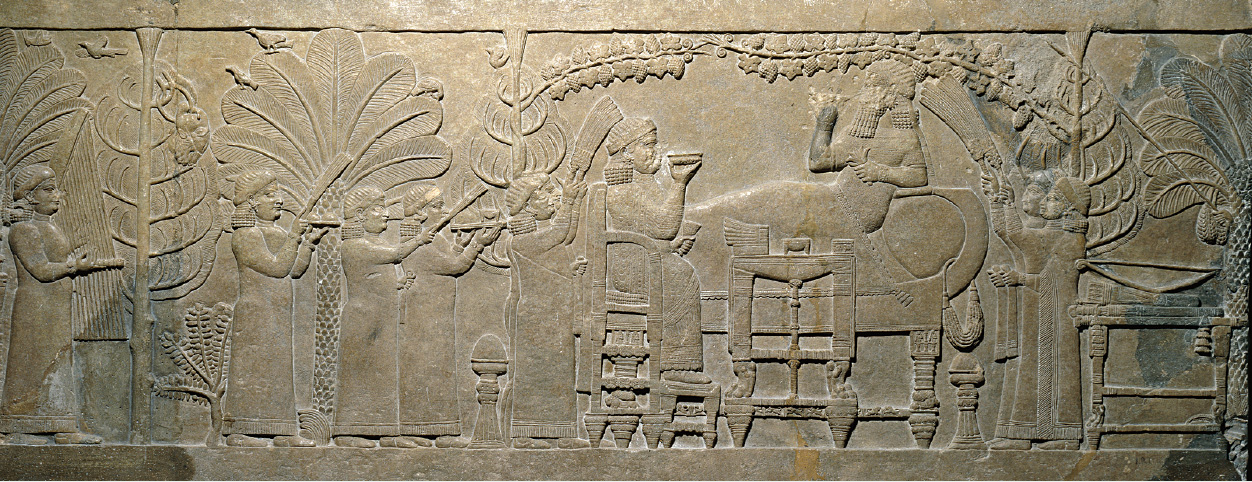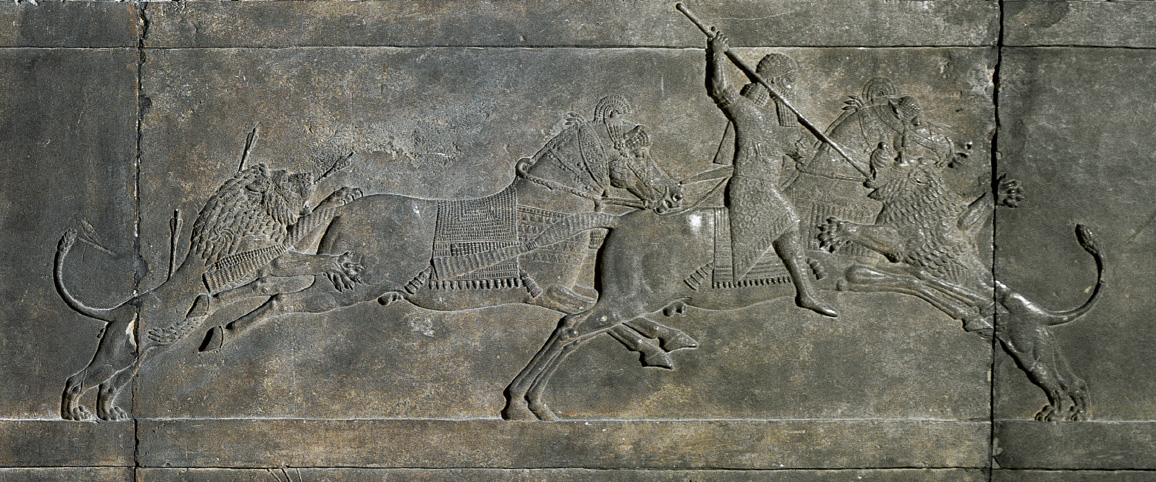Living in the Past: Assyrian Palace Life and Power
In 1854 the British archaeologist W. K. Loftus uncovered the palace of the Assyrian king Ashurbanipal (r. 668–ca. 627 B.C.E.) at Nineveh in modern Iraq. Among its treasures he found carved reliefs that stunningly illustrated royal life and Assyrian power. The friezes shown here decorated the walls of the palace where visitors to Ashurbanipal’s court would see them.
The relief on the top shows Ashurbanipal and his queen enjoying a tranquil banquet in the shade of an arbor. Elegantly clothed, they drink first to the gods. Servants fan them. The king reposes on a lavish couch covered with expensive rugs. The queen sits beside him on an ornate chair, and servants carry in an opulent meal. Other servants play music for the royal couple. In true Assyrian style the seemingly peaceful scene gives a bald message of victory and power. Hanging from the tree on the left is the head of Teumann, king of Elam, whom Ashurbanipal has just defeated in battle. The servants are Teumann’s captured sons.

A frieze of a royal hunt (bottom) depicts a different display of royal power. Ashurbanipal routinely hunted lions, but only partly as sport. Hunting also enabled him to display symbolically his role as the protector of his people. The hunts often took place in the extensive parks that surrounded the royal court. Part of an elaborate ritual, the lions were let loose from pens. When ready, the king advanced either on foot or on horseback. When on foot, he was armed with bow or lance and accompanied only by a shield-bearer. Like a toreador in a bullfight, the king had to face the lion alone. Here King Ashurbanipal is mounted on a stallion that is wide-eyed from fear of the lion beside him. The king wears only a richly embroidered jacket, a kilt, and riding boots. As the lion lunges, the king plunges his spear down the lion’s throat in a public display of his bravery and skill.

QUESTIONS FOR ANALYSIS
Question
9boaRqfIYsI6AJSzi1eohlfZ2kXdGh4C+kQOM/zZbJmWrYfoTyzITwbYsPCoZaJQqWaogH4hDtRJ7GtaHFbrs5ZBSQPjmX1r+dl23avG1CthZQg51Ef5eQeAMS2RhQxZ9k1DWhXPC4GJAmPZUXQTOWOZwah02/+yuoDpUSOCzQdiMfzEAXTIlA==Question
1oki7/pGJWa3USI1T19tQyEvrQx88SKtj9vtYmEKpYVuYAhpD9jrlK+pN/urIW6x5VzrYbns5qkp2t7Rsv82qKbCmRNmU+wc63eW0oOEpkPrBkExPLgTWwdkJ9pp8AEywnE9GCDUsXUIxzFU+LHZMIWKhQMXu3s6c7LXyElS5ludHvFUDzXf5/LO57I6kb7xOyBW1Gl9M/3wDe6FpShrvt4F7SUcWIfc7OyvnBuU2z8V8YDRTpKJ+Bd7HJc=